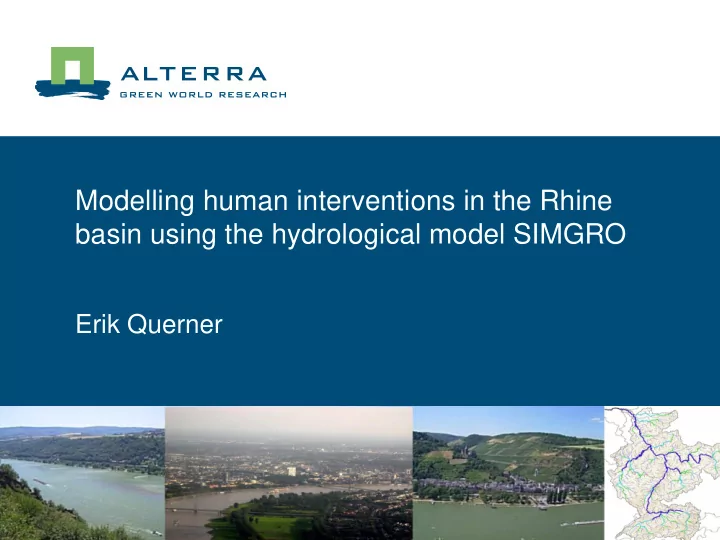

Modelling human interventions in the Rhine basin using the hydrological model SIMGRO Erik Querner
Contents • Introduction framework of the study • Simgro model application to the Rhine basin Climate and land use scenarios • Adaptation measures • Conclusions
Objective of the study • How does a physical based hydrological model perform for a basin as the Rhine (snow module) • Quantify the effect of land use and climate change on river flows • What are the changes on droughts or low flows
Hydrological model SIMGRO
Aim of model SIMGRO • Physical based model • For practical problems and hydrological DTM research Model area Subcatchments Nodes
Modelling the Rhine basin Basin area: 160 000 km 2 Mainly Switzerland, Germany, France, Luxemburg, Belgium >> Netherlands Finite element network: 5 x 5 km ; 8144 cells Surface water: Larger rivers > 400 km 2 630 sub catchments Groundwater: data Rhine Commission (CHR) Land use: CORINE Soil map FAO
Surface water Drainage network is derived from DTM (Voigt e.a., 2007) Important for interaction groundwater – surface water
SW: sub catchments GW: transmissivity & & Duisburg Duisburg K ö ln K ö ln & & Koblenz Koblenz & & Trier Trier & & Mannheim Mannheim & & Stuttgart Nancy Stuttgart Nancy & & & & & Strasbourg & Strasbourg Freiburg Freiburg & & Basel Basel & Z ü rich & Z ü rich & & Bern Bern & &
Gauging stations 42 gauging stations used Procedure to compare calculated-measured discharges in term of Nash- Sutcliffe model efficiency
Lobith – compare measured and calculated
Nash-Sutcliffe modelling efficiency Lobith 0.90 Main 0.74 Neckar 0.65 Moselle 0.79 Switzerland (5 stat) 0.30 Downstr. Switzerl. (13 stat) 0.79
Scenarios • Land use change (extreme) all crops to grass ~ 33% area changed all crops to forest ,, • Climate change scenarios from Dutch Meteorological Institute (standardized)
Climate scenarios for the Netherlands Extreme scenario conform IPCC Moderate Warm
Climate scenarios: some details
Lower than threshold: 88 days 139 153 Threshold (navigation, water use agric., etc)
Scenario – land use
year 1992 • Picture landuse and climat scen
Strategy to follow Is it acceptation or adaptation Note the mark on high water levels (Moselle)
In the past: use of flood levees There is an end in raising dikes
Strategy: analysis concept Rive r Reduced range is flow also favourable in terms of WFD In time • Reduce floods and droughts • Further implications of climate change
• Make use of the groundwater system (retain water in the ground) Before the wet season have enough storage cap. available to cope with peak flows After the wet period save water for the dry period • Natural flood defenses The Ecoflood report gives guidelines on how to restore flood plains
Conclusions • SIMGRO model: has the ability to model practical situations (scenarios like land use and climate change) • Climate change has a much larger impact on discharges and droughts than extreme changes in land use • Consider natural flood defence measures
Is this the challenge we are facing? Is this Acceptation or Adaptation ?
Thank you
Recommend
More recommend